That You Were Never The Same?
Punch-Drunk: The Sobering Truth About Fighting in
Hockey
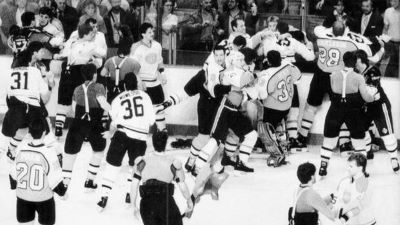
So why am I writing about this subject on a Utah travel blog? Well, I just posted an article on my site about recently attending a Utah Hockey Club NHL game. In the article, I talked about fighting in hockey and how many fans seem to want as much fighting action as possible.
While doing a little reading and researching, I came across some information about a pro hockey player I met many years ago. He died at a relatively young age and the circumstances of his death were tragic. Was he a victim of CTE? I don’t know but it certainly got me thinking. See the comments about Dave Hoyda just below this.
Fighting in the NHL (National Hockey League) has a long and complex history. It is a tradition as old as the game itself. Its continued allowance and even glorification in the league is supported by a mix of traditional, strategic and entertainment factors. Here's a synopsis of why fighting is still a part of NHL hockey despite the apparent risks that few people seem to want to admit out loud.

Traditional Role in Hockey
Enforcement and Deterrence: Traditionally, fighting in hockey served as a form of self-policing among players. Before the countless rule changes and stricter officiating of our present era, players would fight to retaliate against perceived dirty plays usually against star players. It was also used in the same manner to protect smaller or less physical players. This aspect of fighting was often seen as a way to maintain respect among players on the ice.
This is still the mindset of many players, coaches and leagues. Most teams … at least the successful ones … have always had at least one enforcer and they still do. Just the threat of having the other team’s tough guy come after you is often enough to deter over-aggressive or dirty play.
Unwritten Rules: Hockey … like all pro sports … has many unwritten rules and fighting is sometimes viewed as a way to enforce them. For instance, if a player takes a cheap shot at a key player or an over-aggressive hit on a teammate, it might prompt the “enforcer” to go after the offender as a form of immediate retribution. There’s no more effective signal that such behavior won't be tolerated.
One problem is that since so many of these so-called “rules” are unwritten, a lot of it is made up during the game. Many times, players don’t even know what unwritten rule they broke. Maybe it’s a brand new rule that someone just made up.
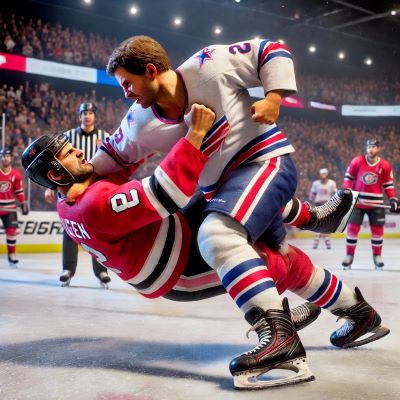
Strategic and Team Dynamics
Momentum Shifts: Fights can be used strategically to shift the momentum of a game. A well-timed fight or a display of toughness will often galvanize a team, boost morale and energize the fans especially at home. This can play a big part in changing the momentum and subsequent course of a game. It happens all the time.
Role of Enforcers: Historically, teams usually included enforcers whose primary role was to fight and intimidate. Many years ago, a fellow Canadian football teammate of mine at Utah told me about his cousin … Dave Hoyda … who had played in the NHL and then had moved to the WHA.
Dave played in a game against the Salt Lake Golden Eagles here in Salt Lake City and we met him at a bar after the game. I believe he had been sent down for injury rehab. From what I can tell, Dave played four seasons of pro hockey. I remember him telling us that the only reason he was playing in pro hockey was because he could fight. He was a tough guy.
If you look Dave up, you’ll see that he died at the age of 57 of tragic circumstances. You can make up your own mind if you dig deep enough. According to one report, he committed suicide in a shocking manner. I am not saying he had CTE but the evidence is highly suggestive. If you’re interested, you can make up your own mind.
Although the role of enforcers has diminished with changes in the game's speed and skill level, most teams still employ players with an aptitude for physical play. This is just part of the game. This physical play, though, often includes fighting to protect teammates and keep opponents in check.
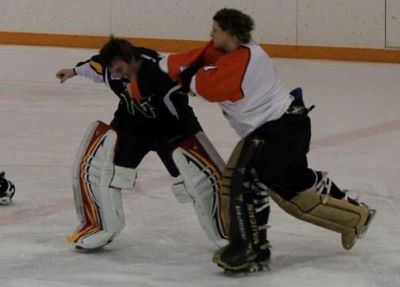
Entertainment Value
Fan Engagement: Fighting undeniably holds entertainment value for a segment of the hockey audience. If you read of my experiences at hockey games in Salt Lake City, you’ll see some of my tongue in cheek comments about some fans going to hockey games to only see the fights.
Obviously, it adds an element of drama and excitement that some fans look forward to. A lot of fans, players, coaches, GM’s, league personnel and TV execs believe it enhances the spectacle of the game. It just adds to the excitement. A good old-fashioned hockey fight gets everyone stirred up.
If you happened to watch the recent 4 Nations Face-off tournament featuring mostly NHL players from four countries, you’ll know what I mean about momentum shifts and fan engagement. The Tkachuk brothers of the US team decided they were going to get their team going from the get-go.
Right at the beginning of the game, three face-offs, three fights. J.T. Miller joined his teammates as all three US players instigated each fight. The fans went nuts. The announcers went crazy. The US team … playing Canada in Montreal … got a big bounce. The US talk shows went bananas.
After the US won the first game, you would’ve thought they had already won the tournament. They later lost the final to the same Canadian team in a game that featured no fights. Even so, Matthew Tkachuk went on to hit the talk show circuit (he was injured during the tournament) and became an even bigger sensation than he was before.
All of this attention was because he and his brother decided to fight rather than play hockey. One little-mentioned aspect is that both Tkachuks picked on opponents much smaller than them. Miller made the mistake of going after Colton Parayko who is 6’6” and 230 lbs. so I’ll give him credit for that.
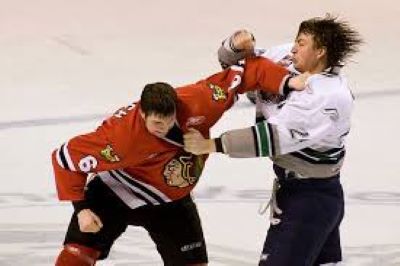
Cultural Expectation: In most hockey markets, especially in North America, fighting is deeply embedded in the culture of the sport. Fans raised with a tradition of hockey fights still expect and demand that physicality as part of the game. You’ll see this part of the game being treated differently in the various levels of hockey however.
- In the Canadian Junior hockey leagues (16 - 20 year-old leagues which produce many of the best NHL players), fighting has always been a big part of the game. This is changing. In the three leagues making up the Canadian Junior Hockey, the Quebec Major Junior League has now banned fighting. The Western Hockey League and the Ontario Hockey League have implemented stricter rules in the last couple years including suspensions. These two leagues don’t have an outright ban yet.
- In Canadian college hockey, fighting isn’t explicitly banned but it is heavily penalized with game misconducts, suspensions and potential league reviews.
- In US college hockey, fighting is banned. Players who engage in fights face penalties including ejections and suspensions.
- In US junior hockey, fighting is common and penalties are issued.
- In International and Olympic hockey, fighting is strictly prohibited. Ejection and suspensions are the immediate result.
- In the pro leagues below the NHL, fighting is common and the same five minute major as the NHL uses is issued.
- Exception – The above-mentioned 4 Nations Face-Off tournament was an NHL-sponsored event with NHL rules and no international rules. Anything allowed in the NHL was allowed in this tournament.
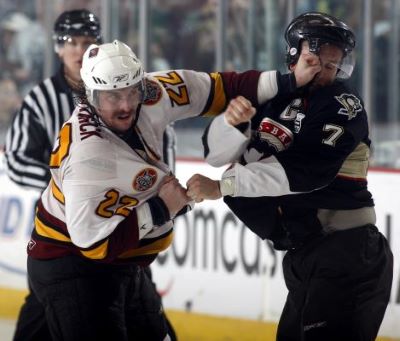
Criticisms and Controversy
Safety Concerns: As understanding of the long-term impacts of concussions and brain injuries has grown, the rationale for allowing fights in hockey has come under increased scrutiny. Concerns about player safety and the long-term consequences of repeated head trauma have led to some calls for stricter regulations or the outright banning of fighting.
Here is my argument that I think simply comes from logical thinking rather than the usual responses by hockey “purists” and uneducated fans.
I remember attending Salt Lake Golden Eagle hockey games way back when I first got to Utah.
As I have stated in another article I wrote about attending a Utah Hockey Club game, it seemed to me that many people came to the games to drink beer and watch the fights. If no fight broke out, the game sucked.
I experienced similar reactions at the recent Utah Hockey Club - Toronto Maple Leaf game I attended recently. Funny thing is, from what I could tell, the fans around me who were calling for fights eventually seemed more entertained by the exciting and lightning-fast hockey action than the one really bad fight.
Changing Game Dynamics: The modern NHL game emphasizes speed, skill, and precision. The rules now, at times, almost seem tickey tack compared to years past. To open the game up offensively, some of the recent rules seem almost ridiculous. If a player gets his stick up around an opposing player’s hands and causes any impedance whatsoever, he is going to the sin bin.
Most of these changes were made to open up the game offensively. More goals mean more excitement. Hooking now can be as simple as getting your stick stuck in any part of the opposing player’s uniform. The difference between a “great hit”, boarding, interference, etc. are dependent on what the referee sees.
Some people argue that fighting slows down the game and detracts from the display of skill that defines contemporary hockey. That may be a legitimate concern but that’s not where I’m going with my argument.
Image and Perception: There is also a concern about the image of the sport. Fighting can be seen as barbaric or unnecessary by new and international audiences. Can this potentially hinder the growth of the sport globally?
Once again, that’s not my concern or argument. MMA, UFC, pro “wrestling”, the NFL, college football and even boxing (seemingly a dying sport) all have rabid and enthusiastic international fans (especially the gladiator-type NFL). All of these sports glorify violence and extreme contact.
The NFL acts like they are concerned about player safety. This often results in ridiculous fines after the fact for things that weren’t even penalized in the game. At least they give the illusion of player safety concern while, at the same time, adding extra games to the regular season.
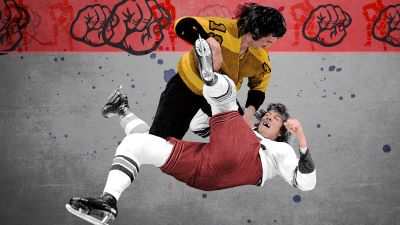
The Disconnect Between NHL “Player Safety” and Fighting
This disconnect has for many years, seemed to me to be about what everything always ends up being about. Money. Say the right words. Come up with the right slogans. Put up some beer commercials. Play the national anthem. Rake in the money. Get contracts with ESPN and TNT.
And now, what is driving the real revenue in sports? Betting!!! They kicked Pete Rose to the gutter for what people like Wayne Gretzky are now making commercials for. I love Wayne but my opinion of him has gone down due to putting his stamp on this.
Face it. The NHL game is awesome to watch. The best sport to view live that there is. NHL rinks are usually full even in the deep southeast US. The most valuable NHL franchise right now … according to Forbes … is the Toronto Maple Leafs.
They are valued at $3.8 billion. Ten years ago, they were valued at $600 million. It’s a rising tide. The success of the league in places like Florida, Carolina, Las Vegas, Dallas, Nashville and California has made all the franchises a lot more valuable.
The correlation between Chronic Traumatic Encephalopathy (CTE) and careers in the NHL, particularly among players who engaged in excessive fighting, is a significant and growing area of research. CTE is a progressive brain condition that is thought to be caused by repeated blows to the head and concussions. It has been notably documented among athletes in contact sports including hockey.
Research Insights:
- Prevalence of CTE among Hockey Players: A study published by Boston University's CTE Center, which is a leader in this field, found evidence of CTE in the brains of several former NHL players. However, the sample size of hockey players studied is still relatively small compared to other sports like American football.
- Columbia University Study: A study by Columbia University found that hockey enforcers, defined as those who had 50 or more career fights, died a decade earlier on average compared to their less pugilistic peers. The study also found that enforcers were more likely to die of suicide and drug overdose which are common occurrences in people with CTE.
- AMA Study: A study of 77 deceased male ice hockey players, which was published in the latest issue of JAMA (the peer-reviewed medical journal of the American Medical Association), found that 18 of 19 National Hockey League players whose brains were studied had CTE.
- Impact of Fighting vs. Regular Play: Players who engage in frequent fights are indeed at a higher risk of repeated concussions which are linked to CTE. Fighting in hockey leads to direct blows to the head which are highly concussive. The argument is that regular physical play in hockey also involves high-speed collisions and impacts which can similarly lead to head trauma. The fact is that fighting is going to result in trauma to the head almost 100% of the time.
- Statistical Data: While there are not a lot of precise statistics detailing the exact correlation between fighting in the NHL and CTE deaths, anecdotal evidence and individual case studies suggest that enforcers (players who fight more frequently) have been more prominently diagnosed with CTE post-mortem. For example, notable NHL enforcers such as Bob Probert, Derek Boogaard and Rick Rypien, who had histories of frequent fighting, were all diagnosed with CTE after their deaths at relatively young ages.
- Comparative Risks: The comparative risks between players who primarily engaged in fighting versus those who didn't but still played physically are less quantitatively established due to the overall rarity of CTE studies specific to NHL players. Most studies do not differentiate the cause of head impacts. They instead focus on the presence of CTE in former players regardless of their specific style of play.
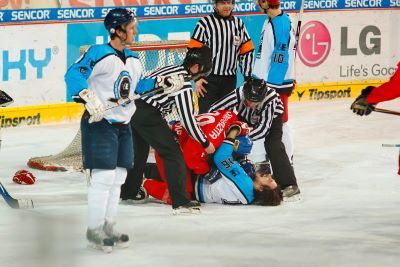
Concluding Thoughts:
While fighting in the NHL is allowed for a variety of reasons … from enforcing the sport's unwritten rules to boosting team morale and engaging fans … it faces increasing criticism due to safety concerns and changing perceptions of the sport. The debate over fighting in hockey continues to evolve as the sport grows and adapts to new understandings of player health and fan preferences.
If you’ve watched NHL hockey at all, you’ll have seen players literally “out on their feet” during or after a fight. They often have to leave the ice to hit the locker room rather than the penalty box. Sure there are big hits that are called clean and part of the game. They are going to happen. It is a physical and aggressive game played at hyper-sonic speeds.
The real stats on CTE in hockey players, especially trying to differentiate between those who fought excessively and those who participated in regular contact play, are not extensively detailed at this point due to the lack of research. Why is the research lacking? One reason might be the complexity of trying to diagnose CTE prior to death.
The majority of the evidence linking CTE with NHL players, specifically in fighters, remains largely anecdotal. At this point, verification of CTE has to be based on posthumous examinations. Getting permission for this is often difficult. A grieving family may not want to endorse such a study.
Ongoing research and increased awareness about sports-related head injuries may provide more statistically significant insights in the future. This will require the brains of more former players to be studied and more data to be gathered.
The NHL, unlike most of the lower leagues, doesn’t seem to be proactive at all in taking action to ward off head hits from fighting. In fact, its glorification seems to be as prevalent as ever.
Have A Comment or Story
About This Topic?
Do you have a comment or story about this article? Share it!










